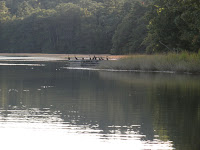 |
| A small monument to a monumental deed. Roy Barnacle photo. |
This small, neglected marker, just steps from my current home, reads: "Knox Trail, Fort Ticonderoga, N. Y., to Cambridge, Mass." The tattered and faded flag, the broken light fixture, and the continually over-filled trash can pay scant tribute to the bravery and exertion this marker commemorates. On an earlier blog, I explained the strategic advantage General Knox won for the American revolutionaries by bringing his caravan of cannon to the battlefront via this one, unguarded bridge. (See map at http://www.wayland.ma.us/Pages/WaylandMA_Veteran/mapvets.pdf) There are other memorials to Knox in this area.
It interested me to realize, on a recent trip to check up on the Waldoboro property, that our two homes are tied via American history.
In Thomaston, Maine, just a few minutes' drive from my former home in Waldoboro, stands the Knox mansion, Montpelier. Although built on land inherited by his wife, the house represents General Knox's reward for service to the new country. The current structure is a 20th century duplicate of the original.
To quote the museum's web site:
In 1795, newly retired, Knox bade farewell to Philadelphia and moved his family to the newly built Montpelier in Thomaston, Maine, to dedicate his "all to the development of the District of Maine." There he had a hand in many of the emerging businesses in midcoast Maine: He shipped timber, quarried lime, made bricks, experimented with agriculture, built a lock and canal system, built many roads, and got involved with land speculation. The elegant house he built at the head of the St. Georges River epitomized the dreams of the young republic. It compared favorably with George Washington's Mount Vernon and Jefferson's Monticello, and Knox made it the center of many enterprises in midcoast Maine, employing many citizens.
(See http://www.generalknoxmuseum.org/montpelier.html for more details.) For a reality check, here is Roy's picture of Montpelier-in-Maine:
 |
| Montpelier in context -- Dragon Cement plant in background. |






























